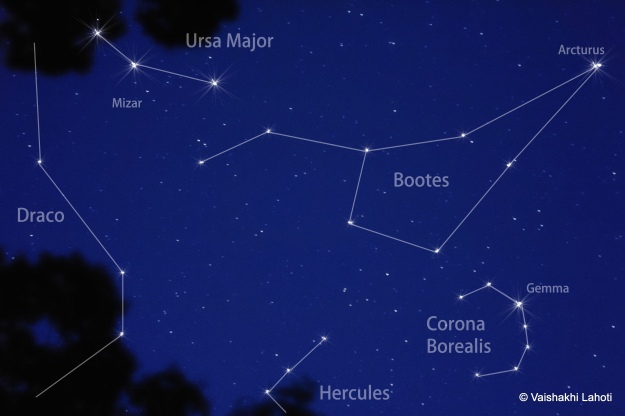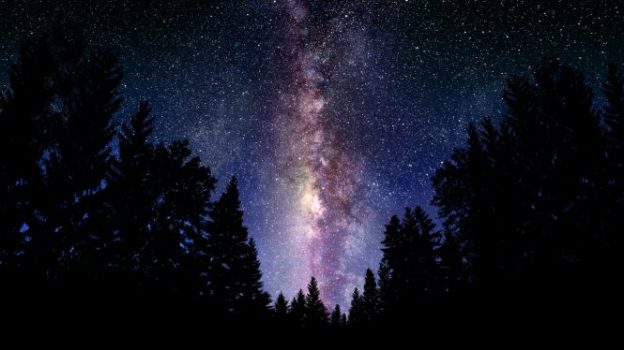In an earlier post I talked about the goddess Matrona, or Mother. This time I want to look at a goddess who is totally unmaternal, Arianrhod. Her story comes from the fourth branch of the Mabinogion, a collection of Welsh early-medieval tales.
Unwilling Mother
The king, Math, is sent away on a pretext, and while he is gone the maiden who serves as his footholder is raped by his rivals. This invalidates her for the job, and to ease her shame Math marries her. But, he is still short a woman’s lap to rest his feet on. His brother, the magician Gwydion, suggests their sister Arianrhod for the footholder.
She was fetched to him; and the maiden came in. ‘Maiden,’ said he, ‘art thou a maiden?’ ‘I know not but that I am.’ The he took the magic wand and bent it. ‘Step over this,’ said he, ‘and if thou art a maiden, I shall know.’ Then she stepped over the magic wand, and with that step she dropped a fine boy-child with rich yellow hair. The boy uttered a loud cry. After the boy’s cry she made for the door, and thereupon dropped a small something… (trans. Jones and Jones: 63)
What she “dropped” was two boys – the blond hero Lleu Llaw Gyffes, and Dylan ail Don, who took to the sea and became a mer-man. (I will discuss the strangeness of this birth, and the relations between Gwydion and Arianrhod, in another post.)
The rest of the story is essentially about Lleu, as Gwydion outwits his mother to win him a name, arms, and eventually a wife. Arianrhod evinces a very un-motherly attitude towards her son, and at each turn she declares she will never give him a name or arms, and curses him that he will never marry a woman of any race on the earth. Gwydion gets around each of these in turn, but Lleu’s wife betrays him to his death. (More about his brother Dylan here.)

Caer Arianhrod on the lower right; as you can see, it’s too low in the sky to be a circumpolar constellation.
Star Goddess, Moon Goddess?
As you might expect from someone whose name means “silver wheel” (from the Welsh arian, “silver,” and rhod, “wheel”) Arianrhod is often assumed to be a goddess of the moon or stars. (The Mabinogion presents us with the same problem as the Irish texts and the Prose Edda – all three start from the premise that the characters are humans, albeit humans with unusual skills. Scholars of all three texts tend to treat these characters as deities.)
Do not, however, make the mistake of thinking that Arianrhod is a simple astral or lunar goddess. Her story is a complex one, and I will be covering various aspects of it over several posts.
The Welsh Triads give Arianrhod a different family – she has a husband, Naf (or Llwas), the son of the sky-god Nwyfre, and two normal sons, Gwenwynwyn and Gwnar. Nwyfre means “firmament”, and he may be a sky and ancestor god to match the ancestral goddess Dôn, from whom both Gwydion and Arianrhod descend.
Arianrhod has her own castle in the Mabinogion, called Caer Arianrhod, of course. Some have seen in this essentially female space – just the goddess and her serving-women, a different version of virginity, which comes up against the patriarchal, Christianized definition that Gwydion and Math accept.
I think this idea is tempting but glosses over the strangeness of the story, as a duel of magic and wits between two deities, the magician who adopts the boy as his own, and his mother who disowns him and tries to thwart him at every turn. (I will be discussing Arianrhod’s duel with Gwydion in another post.)
The Real Caer Arianrhod
Much to my surprise, when I was researching this I came across a couple of sites giving the location of Caer Arianrhod. (Imagine coming across an entry for Valhalla in a guide to Iceland.) Apparently there is a reef off the coast of north Gwynedd, which is called Caer Arianrhod and may well have been intended for the goddess’ coastal castle. It’s not everyday you find an otherworldly location on a map. (It can be seen one kilometre off the Lleyn Peninsula in North Wales between Pontlyfni and Dinas Dinlle, apparently.)
Of course, in Welsh the Northern Crown constellation or Corona Borealis is called Caer Arianhrod, so our goddess has a starry side, or at least a home in the stars. This has led some to see her as a star-goddess. Bayley (59) sees the silver wheel as a wheel of fate, with Arianrhod as the spinner of our lives.
We know from The History of Taliesin that:
My beloved is below,
In the fetter of Arianrod.
and
I have been three periods in the prison of Arianrod;
which many have taken as meaning that Caer Arianrhod is an afterworld, where the souls of the dead go either for good or to be reborn. (The poem seems to imply that Taliesin has lived many times, and seen many things.) This would suggest that, like Ceridwen with her cauldron, Arianrhod was a death/rebirth goddess.
Ariadne and Arachne
Another goddess associated with the constellation is Ariadne, who helped Theseus beat the labyrinth at Knossos. The jewelled crown he gave her was placed in the stars after her death. One name for the Minotaur was Asterion, “Starry”, so there may be some mythology involving the turns of the labyrinth and the motions of the stars that we have lost.
The similarity between Ariadne’s thread (which let Theseus navigate the labyrinth) and Arachne’s web (both as weaver and spider) has led some to suggest that Ariadne was a weaver as well. It may be a reach to suggest that there’s any connection between the Greek and Welsh goddesses, but it is suggestive.
Caer Arianrhod and Caer Sidi
Caer Arianrhod was part of a larger skyscape called Caer Sidi, which means either Zodiac Castle, or else Revolving Castle. Either suggests the sky, with the stars turning through the seasons. Zodiac Castle suggests the whole sky, but if it means Revolving it could be either the whole sky or the pole around which everything else turns.
Caer Sidi is mentioned in the poem Song Before the Sons of Llyr, supposedly composed by Taliesin:
Complete is my chair in Caer Sidi,
No one will be afflicted with disease or old age that may be in it.
It is known to Manawyd and Pryderi.
Three utterances, around the fire, will he sing before it,
And around its borders are the streams of the ocean.
And the fruitful fountain is above it,
Is sweeter than the white wine the liquor therein.
(trans by William F. Skene, 1868)
From what we can tell, Caer Sidi is meant to be one of those Celtic otherworlds where no one ages and everything is paradisiacal. These are usually in some unattainable place, off to the West (Tech Duinn) or hidden in the hollow hills. Some have tried to find a physical location for Caer Sidi, but the stars may be the ultimate in remote spots.
PS – A few websites state that the Crown is a circumpolar constellation, but it isn’t that near to the pole star, and rises and sets. (As you can see in the picture above, it lies between Hercules and Bootes, so it is a summer constellation, best seen in July.) You may be interested to know that in astrology a rising Gemma, the brightest star, means being fond of pleasure, while if it’s setting when you’re born, the same quality becomes excessive, and can end in disgrace. (Noonan: 131)
Links:
Wikipedia entry on Arianrhod
Caer Arianrhod:
Historical Map showing Caer Arianrhod
Three Realms of Arianrhod
Old Photos of the site
Corona Borealis:
Ian Ridpath’s Star Tales entry
Gemma or Alphecca, its brightest star
Mabinogion:
Introduction to the Mabinogion
The Mabinogion and Welsh History
Triads of Wales:
The Triads in pdf form
And as a webpage
References:
Bayley, Michael 1997: Caer Sidhe vol 1: The Celtic Night Sky, Capall Bann.
Davies, Sioned (trans.) 2007: The Mabinogion, OUP. (Kindle)
Jones, Gwyn and Thomas Jones (trans.) 1974: The Mabinogion, Penguin.
Noonan, Gregory 1990: Fixed Stars and Juridical Astrology, American Federation of Astrologers. (Google Books)
Skene, William (trans.): The Book of Taliesen
Zeiser, Sarah E. 2008: ‘Performing a Literary Paternity Test: “Bonedd yr Arwyr” and the Fourth Branch of the “Mabinogi”‘, in The Harvard Celtic Colloquium, 28: 200-15.
If you like the image at the top, click here.




Pingback: Arianrhod, mermen, and sunken islands – We Are Star Stuff
Pingback: The Dark Side of the Sun: Circe, Medea, Pasiphae, Hecate – We Are Star Stuff
Hi there everyone, it’s my first visit at this website, and post is genuinely fruitful in support of me, keep up posting these posts.
LikeLiked by 1 person
Thanks so much, glad to hear you’re finding it useful.
LikeLike
Thank you so much for your posts. I am researching for a novel I am writing about reincarnation, but with a Celtic slant and have found this site very helpful. Luan
LikeLike
Thanks so much, and good luck with your novel.
LikeLike
Pingback: Vindos: Theoretical God – WE ARE STAR STUFF
Pingback: Smith-gods: Goibniu, Gofannon and Cobannos | We Are Star Stuff
This was a fascinating post. I like how you note the strangeness of Arianrhod’s story and how it complicates any attempt to find any quick answers from her lessons. I’ll be coming back to read more posts for sure.
LikeLike
Glad you liked it! Arianrhod’s story is complex and strange – she’s definitely not a one-dimensional deity.
LikeLike